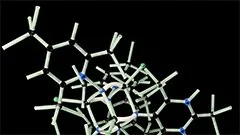Introduction
The chloroplast, a distinctive organelle found within the cells of green plants, algae, and some protists, is responsible for photosynthesis - the process by which solar energy is converted into chemical energy in the form of glucose. This biochemical pathway has been fundamental to life on Earth since at least 2 billion years ago, and continues to play a crucial role in maintaining global carbon dioxide levels and oxygen production. In this comprehensive academic course, we will delve into the intricacies of chloroplast structure, function, biogenesis, and evolutionary significance.
Historical Overview
The discovery of chloroplasts dates back to the 17th century when Antonie van Leeuwenhoek observed green particles within plant cells using a simple microscope. However, it was not until the late 19th and early 20th centuries that scientists began to piece together the role of these organelles in photosynthesis. The concept of endosymbiosis - the idea that chloroplasts originated from free-living cyanobacteria that were engulfed by an ancestral eukaryotic cell and evolved into symbiotic relationships - was first proposed by Lynn Margulis in the 1960s. Today, this theory is widely accepted as a foundational principle of modern cell biology.
Chloroplast Structure
Chloroplasts are roughly spherical or cylindrical organelles with dimensions ranging from 2-7 micrometers in length. They have two main membranes: the outer envelope membrane, which is continuous with the endoplasmic reticulum, and the inner thylakoid membrane, where the majority of photosynthetic reactions occur. Within the thylakoid space, there are stacked membranes known as grana, surrounded by intergranal thylakoids. The stroma, a gel-like matrix, fills the space between these membranes and is rich in enzymes essential for carbon fixation.
Photosynthesis: The Light-Dependent Reactions
Photosynthesis can be divided into two main phases: the light-dependent reactions and the light-independent reactions, or Calvin cycle. During the light-dependent reactions, energy from sunlight is harnessed to produce ATP (adenosine triphosphate) and NADPH (nicotinamide adenine dinucleotide phosphate). This process takes place in the thylakoid membrane and consists of two photosystems: Photosystem I (PSI) and Photosystem II (PSII).
Light Absorption and Excitation Energy Transfer
The initial event in photosynthesis is the absorption of a photon by one of the pigments within the photosystems. In PSII, chlorophyll a absorbs light most efficiently at wavelengths around 680 nm (red) or 540 nm (green). This absorbed energy excites an electron from its ground state to a higher-energy excited state. Excitation energy is then transferred between pigment molecules within the photosystem, allowing for efficient energy capture and utilization.
Water Splitting and Plastoquinone Reduction
The first step in the PSII reaction center is oxidation of water molecules, which results in the production of molecular oxygen and four protons (H+). The electrons extracted from the water are passed through a series of electron carriers to plastoquinone, a lipid-soluble electron carrier. This reduced plastoquinone can then donate its electrons to PSI, thus completing the light-dependent reactions.
Electron Transport and ATP Synthesis in PSI
The electrons from PSII are ultimately accepted by PSI, where they undergo a series of redox reactions and transfer energy to ADP (adenosine diphosphate) to form ATP via the coupling with an ATP synthase complex. Additionally, NADP+ is reduced to NADPH during this process, which serves as a reducing agent in the Calvin cycle.
Photosynthesis: The Light-Independent Reactions (Calvin Cycle)
The Calvin cycle takes place in the stroma of chloroplasts and involves the fixation of carbon dioxide into organic molecules, ultimately resulting in the synthesis of glucose. This process is driven by ATP and NADPH generated during the light-dependent reactions. The Calvin cycle can be divided into three main stages:
Carbon Fixation and Initial Reduction
The initial step of the Calvin cycle is the fixation of carbon dioxide by Rubisco (ribulose-1,5-bisphosphate carboxylase/oxygenase), an enzyme responsible for this critical reaction. This fixed carbon is then converted into a 3-carbon molecule called glyceraldehyde 3-phosphate (G3P), which can be used to synthesize glucose or other carbohydrates.
Regeneration of Ribulose Bisphosphate
In order for the Calvin cycle to continue, ribulose bisphosphate (RuBP) must be regenerated. This is accomplished through a series of enzymatic reactions that convert G3P back into RuBP, allowing for continuous carbon fixation.
Redistribution and Storage of Carbohydrates
The final products of the Calvin cycle can be used for various purposes, such as providing energy for cellular processes or serving as building blocks for other organic molecules. Some of these carbohydrates may be exported from the chloroplast and utilized elsewhere within the plant, while others may remain within the organelle to support its own growth and maintenance.
Chloroplast Biogenesis and Evolution
The biogenesis of chloroplasts is a complex process that involves multiple steps, including the importation of proteins from the cytoplasm, assembly of photosystems, and division of the organelle itself. This intricate process is tightly regulated by various factors, such as the nuclear genome, plastid genome, and environmental conditions.
The evolutionary history of chloroplasts provides valuable insights into the origin and development of photosynthesis. Current evidence suggests that chloroplasts arose from endosymbiotic events between a eukaryotic host cell and cyanobacteria, which were capable of performing oxygenic photosynthesis. Over time, these ancient symbionts became increasingly integrated into their host cells and eventually lost much of their genetic material to the nucleus. Today, chloroplasts exhibit numerous characteristics that reflect both their prokaryotic and eukaryotic origins, making them unique and fascinating organelles in the study of cell biology.
MCQ: Test your knowledge!
Do you think you know everything about this course? Don't fall into the traps, train with MCQs! eBiologie has hundreds of questions to help you master this subject.
These courses might interest you
Create a free account to receive courses, MCQs, and advice to succeed in your studies!
eBiologie offers several eBooks containing MCQ series (5 booklets available free for each subscriber).




